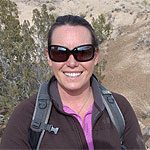This lesson plan was developed as part of the 2012-2016 Great American Biotic Interchange Research Experiences for Teachers Project (GABI RET).
Team
 Megan Hendrickson
Megan Hendrickson
Science Educator
Academy of the Holy Names, FL
 Michael Ziegler
Michael Ziegler
Environmental Sciences and Geology student
Georgia College and State University, GA
Intended Audience
Middle School
Time Frame
84-minute block or 2 45-minute class periods
Standards
NGSS Performance Expectations
MS-ESS2-2 Construct an explanation based on evidence for how geoscience processes have changed Earth’s surface at varying time and spatial scales.
MS-ESS2-3 Analyze and interpret data on the distribution of fossils and rocks, continental shapes, and seafloor structures to provide evidence of the past plate motions.
NGSS Science and Engineering Practices
Constructing Explanations and Designing Solutions
Constructing explanations and designing solutions in 6–8 builds on K–5 experiences and progresses to include constructing explanations and designing solutions supported by multiple sources of evidence consistent with scientific ideas, principles, and theories.
Construct a scientific explanation based on valid and reliable evidence obtained from sources (including the students’ own experiments) and the assumption that theories and laws that describe nature operate today as they did in the past and will continue to do so in the future. (MS-ESS2-2)
Common Core State Standards CCSS
RST.6-8.1 Cite specific textual evidence to support analysis of science and technical texts. (MS-ESS2-2),(MS-ESS2-3)
RST.6-8.7 Integrate quantitative or technical information expressed in words in a text with a version of that information expressed visually (e.g., in a flowchart, diagram, model, graph, or table). (MS-ESS2-3)
MP. 2 Reason abstractly and quantitatively. (MS-ESS2-2),(MS-ESS2-3)
6.EE.B.6 Use variables to represent numbers and write expressions when solving a real-world or mathematical problem; understand that a variable can represent an unknown number, or, depending on the purpose at hand, any number in a specified set.
7.EE.B.4 Use variables to represent quantities in a real-world or mathematical problem, and construct simple equations and inequalities to solve problems by reasoning about the quantities.
Resources & Materials
Geo-morphology PowerPoint – DOWNLOAD
Geo-morphology Mystery Student Handout – DOWNLOAD
Color Printed Geological Feature Photographs
Guiding questions
- How do scientists use observations to make inferences about geo-morphological processes?
- How do you make detailed observations?
- What information is significant to the area of study?
- How do scientists use information to recognize reoccurring or significant features of a locality?
Objectives
Students will be able to:
- Use an interactive notebook to take Cornell notes
- Collaborate with peers during discussions
- Ask questions about process scientists use when identifying fossils and the process scientists use when developing theories
- Create a scientific illustration
- Analyze information from video and print source on a topic
- Name and identify geo-morphological processes in photographs
Assessments
Formative
Examine student worksheet for evidence of thinking and learning. Students should be able to name specific geo-morphological terms and give an explanation of the terms meaning as well as identifying features of the picture their group examined.
Summative
Earth History End of Unit Assessment, Geomorphology Term Quiz
Teaching phase
Direct Instruction/ Whole Group Discussion
- Identify the characteristics of a good observation. What information is included? How do details help you see a specific aspect of a picture? Show pages of scientist’s field journal is available, share pages of teacher journal (if applicable). What do you notice?
- Show and explain the geomorphological processes that shape the Earth. (Are there local examples that you can use to build background for students?)
- Have students give descriptions of geomorphological processes in images and compare/contrast with similar images of the same geo process.
Collaborative Group Activity
- Divide students into pairs or groups of 3.
- Distribute Geomorphology mystery worksheet, explain objective to students.
- Distribute mystery image to students.
- Pairs/groups will have 15-20 minutes to plan their position and 2-3 minutes to present and take questions from other students.
Reading | Writing | Speaking | Listening Strategies
- Reading to obtain information from books, diagrams, videos and articles
- Writing questions and answers in Science Notebook
- Listening to a guest speaker (if available)
- Speaking practice while developing explanations with partners
Learning Progression
Prior Knowledge needed for this lesson
How to record information in science note book.
How to participate in productive discussions with a partner.
Current Knowledge/Skills
How to construct answers using evidence.
How to compare images and identify similarities and differences.
How to use models to explain scientific theory.
Future Skills Connections
How to write a paper to explain a scientific concept.
How to create a detailed illustration to show a scientific concept.